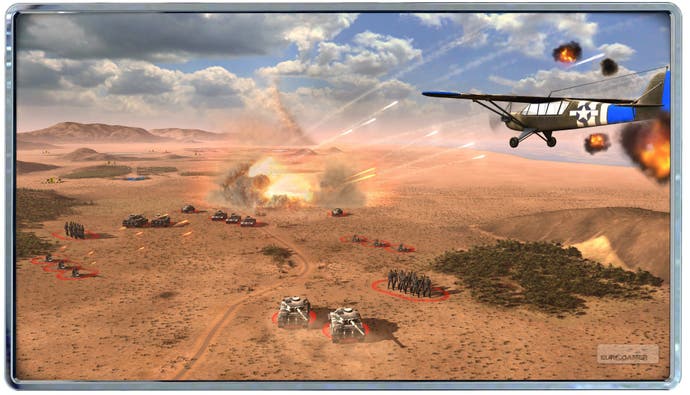R.U.S.E.
Deceptive.
Do I buy their reaction, though? And why should I? "[We] have to teach the AI that an unknown force of enemy units coming towards it is a danger," says Girard afterwards, "so it can divert some forces towards it even though they're your decoys. The AI would actually be able to know that, because it has access to all the memories in the computer, but you have to teach it how to be fooled by the enemy's doing." On the second attempt, I fare much better, deploying radio silence and decoy together, and calling on another non-ruse element - the option to summon bombers from offshore aircraft carriers. You can use up to four at once, after which they need to head home to refuel before they can be used again.
Now more sure of myself, I'm ready for the potentially greater challenge of Monte Cassino. Whereas the Tunisian level represents a fairly traditional RTS battle scenario, Monte Cassino gives you a small task force and asks you to liberate a hilltop town in an area of Italy swarming with axis powers. There's good news for the allies though, and that's, well, that they have allies. In this case, while my three-tank force sneaks across the Italian countryside under cover of the radio silence ruse to eliminate critical anti-aircraft batteries, the British navy keeps the enemy busy with long-range bombardment. That'll teach them for dabbling in National Socialism.
"I think we're striking the genre from a different angle," says Girard, once I'm finished playing, "because it's more about the table, the battle-plan, strategies facing each other, so it's really like being a general instead of being a captain or a lieutenant on the field." Zoom out a bit and units appear like poker chips stacked on the battlefield. Zoom out further and you realise that the black lines on the horizon weren't a preview build error - they were the edges of the table upon which you and your fellow generals are surveying the map and plotting the next move.

Iriszoom certainly brings that home, and while in extreme close-up there's a blandness to RUSE's unit visuals and animations, the environment - plotted from satellite maps, apparently - and environmental effects are decent compensation. The snazzy wheel-spinning zoom function isn't RUSE's only novelty either: Ubisoft has also been showing the game off on giant multi-touch screens - in this case an IntuiSense table - upon which it plays out like a massive iPhone game. There's a bit of lag on control input when I have a go, but there's a lot to be said for dragging the map around by moving two fingers across the surface and pretending you're Tom Cruise in Minority Report. "I can't give you a 100 per cent answer, but there is a fair chance that it will [come out] multi-touch aware or compatible," Girard says when I ask about Windows 7's support for this sort of thing.
Girard is less coy about multiplayer. The game will support four-versus-four, has "a good number of maps - at least the good minimum you'd expect from an RTS", a separate skirmish mode for a mixture of human and AI players, and "another mode which we're going to uncover in Cologne". Single-player or multiplayer? A pause. "In between!" One thing it won't have though is a level editor. "It's not a simple thing," says Girard, trying not to lament the satellite-data map-making. "The maps are gorgeous but they're a bit complex."
The most promising thing about all this, though, is that all questions of World War II and console controls have evaporated (the PC controls, incidentally, are similarly basic and intuitive). "The depth of the game is not reduced by the fact you can play with the pad," says Girard, by way of explanation. "Since it's a game about strategy, about huge battle-plans, you don't need micro action or lots of keyboard shortcuts." It's almost wrong to call it an RTS, I suggest. "Maybe you could call it real strategy. In real time."
RUSE is due out for PC, PS3 and Xbox 360 in Q1 2010.

